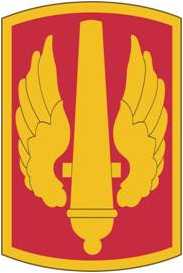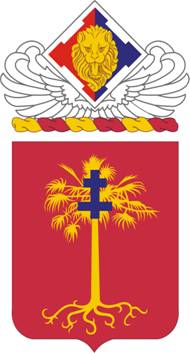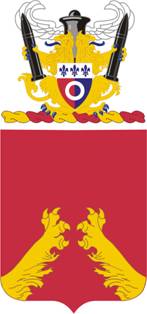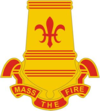
The 82nd Airborne Division is an airborne infantry division of the United States Army specializing in parachute assault operations into denied areas with a U.S. Department of Defense requirement to "respond to crisis contingencies anywhere in the world within 18 hours". Based at Fort Liberty, North Carolina, the 82nd Airborne Division is part of the XVIII Airborne Corps. The 82nd Airborne Division is the U.S. Army's most strategically mobile division.

The 1st Battalion, 320th Field Artillery Regiment is the field artillery battalion assigned to the 2nd Brigade Combat Team, 101st Airborne Division. The battalion has been assigned to the 82nd Airborne Division, 11th Airborne Division and 101st Airborne Division. The battalion has participated in World War I, World War II, Operation Power Pack, Operation Urgent Fury, Operation Desert Storm, Operation Iraqi Freedom, Operation Enduring Freedom, and Operation Inherent Resolve.

The 18th Field Artillery Brigade is the XVIII Airborne Corps field artillery brigade, based at Fort Bragg, North Carolina.

The 4th Battalion, 319th Field Artillery Regiment is the field artillery battalion assigned to the 173rd Airborne Brigade. Nicknamed "The King of the Herd", 4–319th AFAR has participated in battles from World War I to current operations around the globe. The battalion's mission is to provide direct supporting fires to the brigade. The unit is skilled in both the art of integrating and synchronizing all available fire support assets and in the science of delivering accurate and timely lethal and non-lethal fires. "King of the Herd" Paratroopers in the 173rd Infantry Brigade Combat Team (Airborne) are able to accomplish both of these tasks and other assigned missions after rapidly deploying via parachute assault.

The 3rd Battalion, 319th Field Artillery Regiment is the field artillery battalion that directly supports the 1st Brigade Combat Team, 82nd Airborne Division. Known as the "Gun Devils", 3–319th AFAR has participated in battles from World War I to the current day, and is one of the most highly decorated field artillery units in the United States Army. The battalion's mission is "3-319th AFAR stands ready to deploy worldwide within 18 hours of notification, execute a parachute assault and conduct full-spectrum operations. Specifically, the battalion will provide responsive lethal and nonlethal fires in support of forcible entry and airfield seizure, and integrate and synchronize the effects of fires to achieve the 1BCT commander's intent."

The 319th Field Artillery Regiment, more commonly referred to as the 319th Airborne Field Artillery Regiment, is a parent regiment in the U.S. Army Regimental System. Four battalions of the regiment are currently active. The first three battalions 1st Battalion, 319th Field Artillery Regiment, 2nd Battalion, 319th Field Artillery Regiment, 3rd Battalion, 319th Field Artillery Regiment are in the 82nd Airborne Division and the 4th Battalion, 319th Field Artillery Regiment is in the 173rd Airborne Brigade.

The 320th Field Artillery Regiment is a field artillery regiment of the United States Army. A parent regiment under the U.S. Army Regimental System, the 320th FAR currently has two active elements in the 101st Airborne Division : 1st Battalion, 320th FAR "Top Guns" in 2nd Brigade Combat Team; and 3rd Battalion, 320th FAR "Red Knight Rakkasans" in 3rd Brigade Combat Team. The regiment served with the 82nd Airborne Division during World Wars I and II, and regimental elements have served with the 82nd and 101st Airborne Division, the 193rd Infantry Brigade and the Berlin Brigade, and conducted combat operations in the Dominican Republic, Vietnam, Grenada, Operations Desert Shield and Storm, and the Global War on Terror.

The 321st Field Artillery Regiment is a field artillery regiment of the United States Army. A parent regiment under the U.S. Army Regimental System, the 321st FAR currently has one active battalion, the 3rd Battalion, 321st FAR, assigned to the 18th Field Artillery Brigade at Fort Bragg, NC. The battalion is equipped with M142 HIMARS.
The regiment served with the 82nd Division during World War I and with the 101st Airborne Division during World War II. Elements of the regiment have served with the 82nd and 101st Airborne Divisions in Vietnam, and with the 82nd Airborne Division and 18th Field Artillery Brigade during the Global War on Terrorism.
The 377th Field Artillery Regiment is a field artillery regiment of the United States Army. A parent regiment under the U.S. Army Regimental System, the regiment's 2nd Battalion, 377th Field Artillery Regiment is assigned to the 2nd Infantry Brigade Combat Team (Airborne), 11th Airborne Division. Elements of the regiment have also served with the 101st Airborne Division and 82nd Airborne Division, and have seen service in World War II, Vietnam, and in both Iraq and Afghanistan during the Global War on Terror. The 1st and 3rd Battalions as well as Batteries D and E are Inactive.
The 1st Battalion, 319th Airborne Field Artillery Regiment is the airborne field artillery battalion assigned to the 3rd Brigade Combat Team, 82nd Airborne Division. Nicknamed "Loyalty", 1–319 AFAR has deployed to conduct combat operations in the Dominican Republic, Grenada, Kuwait, Afghanistan and three separate deployments to Iraq. Most recently, the battalion deployed to Afghanistan in support of Operation Freedom Sentinel.
The 2nd Battalion, 319th Field Artillery Regiment is the field artillery battalion that is assigned to the 2nd Brigade Combat Team, 82nd Airborne Division. Nicknamed "Black Falcons", 2–319 AFAR has participated in battles from World War I to the current day.

The 3rd Battalion, 321st Field Artillery Regiment is an artillery battalion, assigned to the 18th Field Artillery Brigade, part of the US Army XVIII Airborne Corps at Fort Bragg, NC. The battalion has served in World War I, World War II, and the Global War on Terror. The battalion is equipped with M142 HIMARS rocket launchers.

The 1st Battalion, 321st Field Artillery Regiment is an inactive field artillery battalion of the United States Army. The battalion served in World War I, World War II, Vietnam and the Global War on Terror with the 82nd Airborne and 101st Airborne Divisions, and with the 18th Field Artillery Brigade. The battalion was officially inactivated in March 2014, and its firing batteries were distributed throughout the 82nd Airborne Division.

The 2nd Battalion, 321st Field Artillery Regiment is an inactive field artillery battalion of the United States Army. The battalion served in World War I, World War II, Vietnam and the Global War on Terrorism with the 82nd Airborne and 101st Airborne Divisions. The battalion was inactivated in 2014 as part of force reductions.

The 101st Airborne Division Artillery (DIVARTY) is the force fires headquarters for the 101st Airborne Division at Fort Campbell, Kentucky. The DIVARTY has served with the division in World War II, Vietnam, Operations Desert Shield and Storm, Operation Iraqi Freedom, and in peacetime at Camp Breckinridge and Fort Campbell, Kentucky, and Fort Jackson, South Carolina. The DIVARTY was inactivated in 2005 as part of transformation to modular brigade combat teams, but was reactivated on 16 October 2014 to provide fire support coordination and mission command for the training and readiness of field artillery units across the division.

The 2nd Battalion, 320th Field Artillery Regiment is an inactive field artillery battalion of the United States Army. The battalion has been assigned to the 82nd Airborne Division, 11th Airborne Division and 101st Airborne Division. The battalion has participated in World War I, World War II, Vietnam, Operation Desert Storm, Operation Iraqi Freedom, and Operation Enduring Freedom. The battalion deactivated in July 2015 as part of ongoing force reductions, and its personnel and equipment were reflagged as the 2nd Battalion, 32nd Field Artillery Regiment.

The 3rd Battalion, 320th Field Artillery Regiment is a Field Artillery Branch battalion assigned to the 3rd Brigade Combat Team, 101st Airborne Division. The battalion has been assigned to the 82nd Airborne Division, 11th Airborne Division and 101st Airborne Division. The battalion has participated in World War I, World War II, Operation Desert Storm, Operation Enduring Freedom, and Operation Iraqi Freedom.

The 4th Battalion, 320th Field Artillery Regiment is an inactive field artillery battalion of the United States Army. The battalion has been assigned to the 82nd Airborne Division, 11th Airborne Division and 101st Airborne Division. The battalion has participated in World War I, World War II, Operation Just Cause, Operation Iraqi Freedom, and Operation Enduring Freedom. The battalion inactivated in 2014 as part of ongoing force reductions
The 376th Parachute Field Artillery Battalion is an inactive airborne field artillery battalion of the United States Army. Active with the 82nd Airborne Division from 1942–1957, the 376th PFAB saw action during World War II in Sicily, Italy, the Netherlands, the Battle of the Bulge, and Germany, often serving in support of the 504th Parachute Infantry Regimental Combat Team.
In 1989, the United States Army Pacific had its headquarters at Fort Shafter in Hawaii, and its units were stationed within the United States. Overseas forces included the US Army Japan, and the Eighth US Army in South Korea.
















